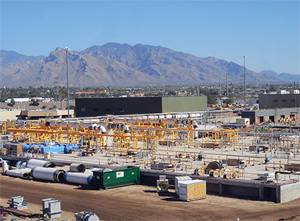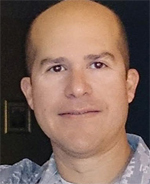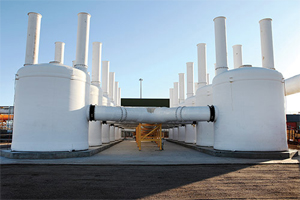Utility Transformation — From WWTP To Reuse Facility
By Michael Haarmann, John Cevaal, and Jaime Rivera
Facing state Department of Environmental Quality mandates, an Arizona wastewater treatment plant (WWTP) took on a large-scale expansion project and effluent-quality upgrade to become a state-of-the-art water reclamation facility.
As Arizona’s population continues to grow, water will become even harder to come by. Without a plentiful supply of groundwater, surface water, or precipitation, all that’s left is recycled or reclaimed water — requiring thoughtful conservation.
MWH Constructors, the U.S. global construction firm, began work on the original Ina Road Wastewater Treatment Facility, located in Pima County, AZ, in August 2010 to transform it into the state-of-the-art Tres Rios Water Reclamation Facility (WRF). The project was completed in October 2013.
The Tres Rios WRF has provided measurable impacts to the Pima County and Tucson community, including making the most of sewer user fees through innovations that produced the best plant possible, creating a pristine habitat for fish and birds near the Santa Cruz River, providing one of the most sustainable water treatment facilities in the area, and creating more than 700 jobs in the three-year construction period.
In order to comply with regulatory requirements set by the Arizona Department of Environmental Quality (ADEQ), the Pima County Regional Wastewater Reclamation Department reduced the total nitrogen and phosphorus concentrations in the effluent it discharged into the Santa Cruz River.
Two-Part Solution For A Desert Community
The Tres Rios WRF is located in Pima County, AZ, near West Ina Road and Interstate 10, and as of the 2010 census, the population was 980,263 — making it the second most populous county in Arizona.
 The original Ina Road facility began operating in 1977; it was a 25 MGD treatment plant used to treat the community’s Northside wastewater flows. A 12.5 MGD expansion was completed in 2006, but to meet the ADEQ mandates, the facility needed significant upgrades to its effluent discharge standards. When MWH Constructors began construction on the $232 million project in August 2010, the firm expanded the plant’s capacity from 37.5 MGD to 50 MGD, as well as replaced the outdated wastewater treatment plant with a water reclamation plant.
The original Ina Road facility began operating in 1977; it was a 25 MGD treatment plant used to treat the community’s Northside wastewater flows. A 12.5 MGD expansion was completed in 2006, but to meet the ADEQ mandates, the facility needed significant upgrades to its effluent discharge standards. When MWH Constructors began construction on the $232 million project in August 2010, the firm expanded the plant’s capacity from 37.5 MGD to 50 MGD, as well as replaced the outdated wastewater treatment plant with a water reclamation plant.
The capacity expansion project and effluent-quality upgrade were components of the Regional Optimization Master Plan (ROMP) — a key effort in Pima County to upgrade the wastewater infrastructure. The ROMP plan comprised four parts: a 72” interconnected sewer pipeline; a water, energy, and sustainability center that included a National Environmental Laboratory Accreditation Conference and training center; a new 32 MGD water reclamation campus, known as the Agua Nueva WRF; and an upgrade and expansion of the Ina Road Wastewater Treatment Facility. With the replacement of the 41 MGD Roger Road plant with the 32 MGD Agua Nueva WRF, capacity had to be added to the original Ina Road facility to produce more water per day and upgrade the pre-existing facility.
Key components of the project:
- Constructing a new 25 MGD ammonia/nitrogen/nutrient removal process system (five-stage Bardenpho) to replace an existing 25 MGD high-purity oxygen (HPO) train
![]()
- Upgrading the existing 18 MGD biological nutrient removal activated sludge (BNRAS) process train for additional ammonia/nitrogen/ nutrient removal and increasing its capacity to 25 MGD
- Modifying effluent disinfection facilities using sodium hypochlorite technology followed by dechlorination
- Incorporating a new state-of-the- art blower building facility with two new 1,000 HP blowers into the west train facilities
- Constructing a new pump station for digested sludge and wasteactivated sludge (WAS) and associated recycle storage tanks
- Adding a new WAS thickening facility with three new gravity belt thickeners (GTB) and new odor control equipment
- Upgrading to a new 46 kV distribution system the former utility power supply for the Tres Rios WRF, which included a 4,160 V distribution system for the older sections of the plant to 13.8 kV distribution system for the newer sections of the plant.
Despite Challenges, MWH Constructors Remained Ahead Of Schedule
MWH Constructors was selected as construction manager-at-risk (CMAR) on the project and performed approximately $48 million of work, including procurement, installation of process piping and equipment, instrumentation and control, and commissioning and startup. The CMAR method allowed MWH Constructors the opportunity to do a significant amount of work on the project, while also managing quality control and staying on schedule.
The Tres Rios project included 280,000 cubic yards of material excavation, and the deepest excavation was for the plant drain pump station, which was 65’ deep. The pump station excavation used a combination of open cut excavation and shoring. Other excavations on the site were an average of 30’ deep. By upgrading the capacity and expanding the treatment plant, this project developed the highest quality effluent possible in order to meet Pima County’s sustainability goals.
During material excavation for the digesters, the team discovered 3,000-year-old artifacts, requiring MWH Constructors to adjust and relocate resources to work in another area of the site, saving the owner at least six months in potential delays. Despite this difficulty, MWH Constructors successfully completed the project through coordination, construction sequencing, and phased process facility startups. Coordination with archeologists and researchers led to the recovery of more than 70,000 artifacts, which were then donated to the Arizona State Museum.
One of the most significant challenges was maintaining continuous operation of the existing plant at a minimum treatment capacity during construction. The team developed hundreds of Maintenance of Plant Operation (MOPO) plans to make necessary connections between the existing and new process facilities. Critical MOPOs included the placement of a 35’-long influent screw pump at the headworks, tie-in of new blowers into the existing blower header, transfer from the existing powerhouse to the new thermal energy facility, and electrical transfers to the new 46 kV substation and switchgear facilities. The successful transition from the old power distribution systems to the new power distribution system was a key factor in the overall success of the project.
The Building Information Modeling (BIM) was also an asset in all stages of the project. This tool allowed development of the design in 3D, with the creation of visualization models to communicate the design’s intent. During construction, the BIM models were used to identify and proactively resolve field questions and construction conflicts in order to stay on budget and on schedule.
Finally, the project team incorporated a five-stage Bardenpho treatment process. This process biologically removes the organic matter, nitrogen, and phosphorous from the wastewater stream and features an initial anaerobic zone to promote biological phosphorous removal, an anoxic zone for denitrification, and an aerobic zone for organic reduction and nitrification. A second anoxic and aerobic zone provides final denitrification. Odors were addressed through development of a systemwide odor control master plan, which called for state-of-the-art odor control systems, including carbon absorbers, ammonia scrubbers, and biofilters.
The upgrade and expansion of the Tres Rios WRF facility provided the highest quality effluent, classified as A+ reuse. The project was upgraded with state-of-the-art technology, automation, and process controls to further enhance efficiencies and provide a significant supply of water to take Pima County well into the future and reduce the dependency on groundwater.
About The Authors

Michael Haarmann of MWH Constructors, Inc. served as project manager on the Pima County Tres Rios WRF project. He has more than 17 years’ experience providing construction services to clients, including wastewater treatment plants, power generation, manufacturing, and commercial.

John Cevaal, VP, MWH Constructors, Inc., has 31 years’ experience as a project manager, regional manager, and director of operations. He holds a BS in civil engineering from the Colorado School of Mines and Calvin College and is a registered general building contractor in New Mexico and California.

Jaime Rivera is program manager for the Pima County Regional Wastewater Reclamation Department (RWRD) and provides oversight of the Capital Improvement Program (CIP), including the $310 million Ina Road upgrade and expansion project.

